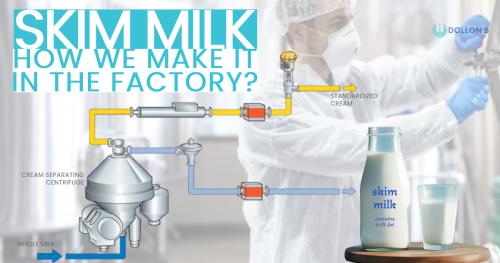Skim Milk Production in Milk Processing Plants

Very often we come across statements stating that “Milk causes obesity” or “consumption of milk leads to weight gain”. These are mere misconceptions and you must not let them dwell in your healthy mind with such thoughts. If you are unable to come out of this misconception, let us break the ice. As a leading milk processing plant in India, we are processing and distributing more than 600000 liters of milk every day, and, it is increasing year over year. There is a milk variant known as skim milk or skimmed milk that contains the least fat content. In this article, we will discuss how leading Milk Processing Plants like ours produce skim milk.
What is Skim Milk or Skimmed Milk?
Skim milk is a form of milk that has had practically all of its fat removed. It is sometimes referred to as fat-free milk or non-fat milk. In most cases, centrifugation is used to separate the fat from the milk; the fat is then removed, leaving behind a milk product with very little fat.
Skim milk is a well-liked option for people who want to consume less fat in their diet but still get the nutritional advantages of milk. Like whole milk, it is packed with vital elements like protein, calcium, and vitamin D, but with a far lower fat level. Skim milk can be drunk on its own or as a component of a variety of dairy products. It is frequently used in recipes, particularly those for baking and cooking.
Process of Skim Milk Production in Milk Processing Plants
Milk Processing plants produce skim milk through a process that removes most of the fat content from whole milk. Here’s an overview of the production process:
- Separation: The first step in producing skim milk is to separate the fat from the whole milk. This is typically done in a centrifuge, where the milk is spun at high speeds. The fat globules are lighter and separate from the rest of the milk, forming a cream layer on top.
- Skimming: Once the fat has been separated, it is removed to create whole milk. This process leaves behind skim milk, which contains less than 0.5% fat content, making it a low-fat or fat-free dairy product.
- Homogenization (optional): Some manufacturers choose to homogenize skim milk, which is the process of breaking down fat globules to prevent them from separating and floating to the top. Homogenization creates a smoother, more uniform texture.
- Pasteurization: To ensure the milk is safe to consume, it is typically pasteurized by heating it to a specific temperature and then rapidly cooling it. This process kills harmful bacteria and extends the milk’s shelf life.
- Packaging: The final step is to package the skim milk into containers suitable for retail sale.
Skim milk is commonly used as a low-fat alternative to whole milk in various recipes. It’s also a popular choice for those looking to reduce their fat intake while still enjoying the nutritional benefits of milk, such as calcium and protein.
Nutrition and Health Benefits of Skim or Skimmed Milk
Milk processing plants produce skimmed milk, fat-free, non-fat, or skim milk by straining off all of the cream from whole milk. As a result, it contains only about 0.1% fat and a significant reduction in calories when compared to full-fat milk. These fat-soluble vitamins are frequently lost during the fat-removal process. Therefore, they are fortified with vitamin A and vitamin D. They also contain important elements like phosphate, calcium, and vitamins B2 and B12.
One of the health advantages of skim milk consumption is better blood sugar regulation along with weight loss and management. Additionally, it enhances muscle performance, and healthy bone mineral density, and controls blood pressure and cholesterol levels.
Skimming the Fact!
Despite being marketed as “fat-free,” skim milk still has roughly 0.1% of its original fat content. When it comes to adult weight loss, skim milk is a smart option for calorie control. However, this never establishes the fact that whole milk causes obesity or weight gain. Obesity is a complex condition that results from a combination of factors, including genetics, diet, physical activity, and overall lifestyle. Consuming milk in moderation as part of a balanced diet is unlikely to cause obesity.
As we churn out the fat from the milk in the centrifuge, you simply skim out the misconception and drink a glassful of milk every day for a healthy life.
Post Your Ad Here
Comments